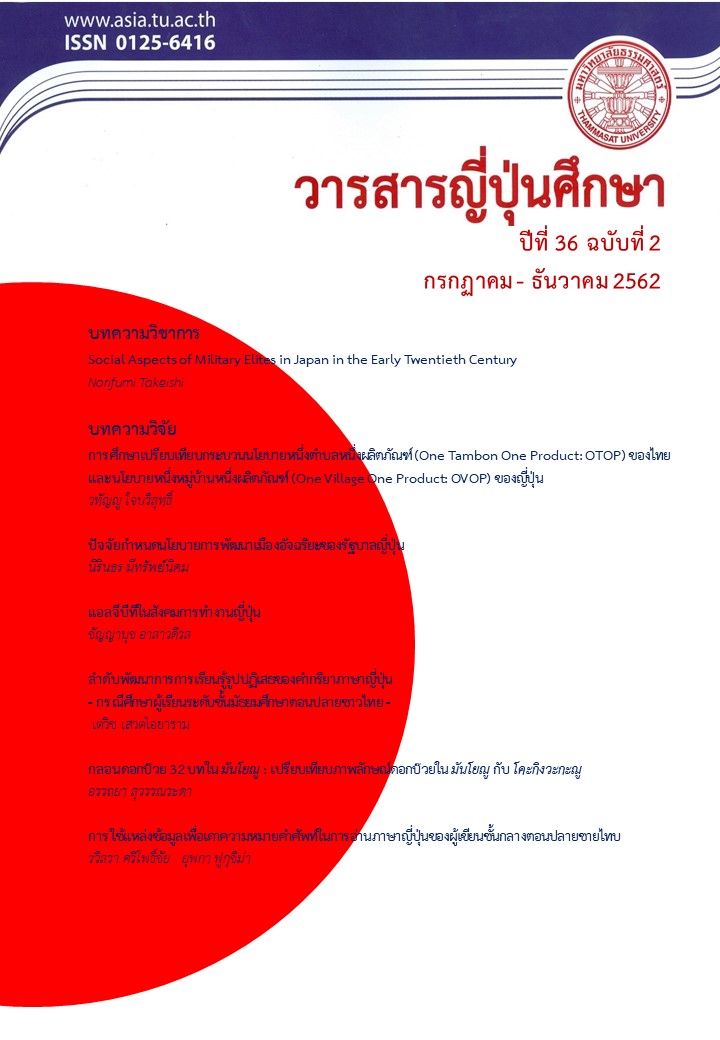The Use of Knowledge Sources in Lexical Inference Strategies in Japanese Reading of Thai Learners at an Intermediate-High Level
Keywords:
Knowledge sources, Lexical inference strategies, Japanese readingAbstract
The purpose of this research was to investigate and analyze the use of knowledge sources in lexical inference strategies in Japanese reading of Thai learners at an intermediate-high level. The participants were 28 Thai learners who passed the Japanese-Language Proficiency Test (JLPT) at N2 level. The research instruments used in this study was a guessing
meaning test. The results revealed that the overall success rate of lexical inferencing was moderate. The top 3 types of the knowledge sources in lexical inference strategies used by Thai
learners were as follows: 1) word level 2) sentence level and 3) word and sentence level while the top 3 types of the successful knowledge sources in lexical inferencing were as follows: 1) word level 2) word and sentence level and 3) sentence level. However, for the inference the meaning of unknown words, the using a knowledge source from context (sentence level and discourse level) will be more successful than the using a knowledge source with a target word level a little.
Downloads
References
nihongo gakushuusha no goi gakushuu sutoratejii no shiyou jittai: hoshuu jugyou jukousha o taishou ni shite. Journal of Japanese Language and Culture, (11), 39-65. (in Japanese) Huckin, T. and J. Bloch. (1993). Strategies for Inferring. Word-Meanings in Context: A cognitive model. In T. Huckin, M. Haynes, and J. Coady (eds.), Second Language Reading and Vocabulary Learning. (pp. 153-178). New Jersey: Ablex. Ishibashi, Reiko. (2009). Taijin gakushuusha no gengo gakushuu sutoratejii shiyou: sokudoku sukiru o donyuushita baai. Ajia ni okeru Nihongo Kyouiku: Gaikokugo toshite no Nihongo Shuushi Katei Setsuritsu Isshuunen Seminaa Ronbunshuu, 73-88. (in Japanese) Japan Foundation and Japan Educational Exchanges and Services. (2012). Japanese Language Proficiency Test Official
Practice Workbook N2. Tokyo: Bonjinsha. (in Japanese) Mori, Yoshiko. (2002). Individual differences in the integration of information from context and word parts in interpreting unknown Kanji words. Applied Psycholinguistics, 23, 375-397. Nassaji, H. (2003). L2 vocabulary learning from context: Strategies, knowledge sources, and their relationship with success in L2 lexical inferencing. Tesol Quarterly, 37(4), 645-670. Noda, Hisashi. (2014). Joukyuu nihongo gakushuusha ga gakujutsu ronbun o yomu toki no houhou to kadai. Journal of Technical Japanese Education, 16, 9-14. (in Japanese) Nomura, Masaaki. (1999). Basic 3000 Chinese-styled words based on statistical research in modern Japanese. Bulletin of Center for Japanese Language, Waseda University, (12), 21-54. (in Japanese) O’ Malley, J. M. and A. U. Chamot. (1990). Learning Strategies in Second Language Acquisition. Cambridge: Cambridge University. Oxford, R. L. (1990). Language Learning Strategies: What Every Teachers Should Know. Boston: Heinle and Heinle. Rubin, J. (1987). Learner Strategies:
Theoretical assumptions, research history and typology. In A. Wenden and J. Rubin. (eds.). Learner Strategies in Language Learning. (pp. 15-30). Hertfordshire: Prentice Hall International. Sanguansri, Thanyarat. (2016). Relationship between reading anxiety, language learning anxiety, and reading comprehension in Japanese as a foreign language: a case of Thai college students. Studies in Language Sciences, 22, 45-64. (in Japanese) Ulambayar, Tsetsegdulam. (2013). The efficacy of instruction encouraging lexical inference of the meaning of unknown Kanji words: from the perspective of the use and accuracy of knowledge sources at lexical inference. Acquisition of Japanese as a Second Language, 16, 178-195. (in Japanese) Yamagata, Junko. (2008). Japanese learners' lexical inferencing in text comprehension: the effects of L2 linguistic knowledge and native language background. Japanese Language Teaching, 139, 42-51. (in Japanese)
Yamagata, Junko. (2013). Dainigengo Dokkai ni okeru Goi Suisoku: Goi Chishiki, Bogo Haikei, oyobi, Tekusuto no Topikku e no Najimi Fukasa ga Oyobosu Eikyou. Doctorial dissertation, Kanda University of International Studies. (in Japanese)




